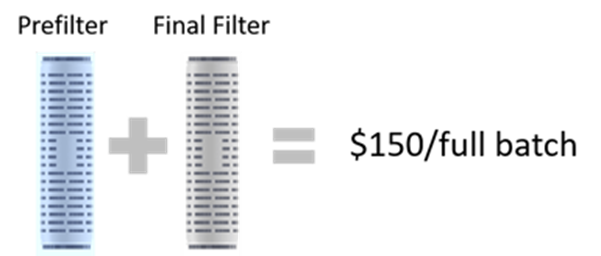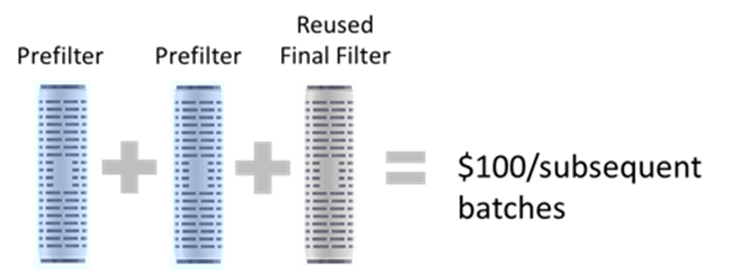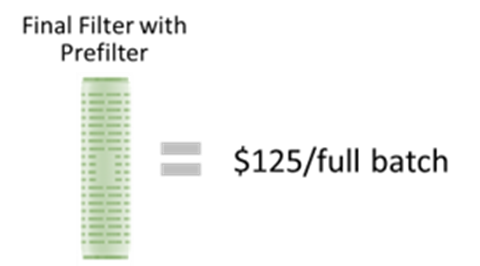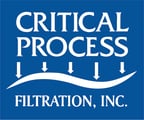What if you could extend the life of your final filters, improve process efficiency and lower filtration costs? With the right Prefiltration strategy, you can.
In every process, the final filter plays the most critical role in assuring that your filtrate meets expectations and requirements. It is typically the most expensive filter as well. The useful life span of a final filter will determine your change-out schedule and impact your filtration costs.
Whether your process is removing unwanted particles, clarifying your product to improve aesthetics, or sterilizing a product by removing bacteria, your operation can most likely benefit from prefiltration.
Typically, if you want to reduce filtration costs you would find a way to buy fewer filters or search for better pricing. However, incorporating a prefiltration strategy will take you down a different path. The filters you are using already cost a lot, so let’s explore how “adding more filters” actually ends up saving you money in the long run.
Your filters foul before completing a batch.
Your final product meets all specifications, so the filters appear to be doing their job. But fouling (filter membrane pores are clogged by contaminants) during batch processing requires shutting down mid-process to install new filters. This results in increased processing times, and might cause product loss when the filter housings are emptied and refilled. For sterilizing applications, this could even lead to a break in your sterile process, requiring system cleaning before the process can continue.
One solution would be to increase the size of your filter system and install more of the same filters you are already using. A better solution could be to look at installing lower-cost prefilters to extend the life of your more expensive final filters. The prefilter could take the load off the final filter, and with proper selection and sizing allow processing of a full batch.
How does adding more filters save me money?
Let’s assume it currently requires two sets of filters to complete a batch. Doubling the amount of the filters currently in use would allow filtering the entire batch, but wouldn’t result in cost savings (other than the inherent cost of process interruption). If you could install a less expensive prefilter before the final filter, this might allow the combination to process an entire batch without adding more of the pricier final filters.
Cost reduction with one prefilter.
Say your current filters cost $100 each. If it requires two filters per batch, then the filter cost per batch is $200. This is true whether you change filters during the process or double up to allow the processing of the entire batch without stopping. But if installing a $50 prefilter (instead of the 2nd final filter) allows processing the entire batch, then your filter cost per batch has gone down to $150 (or 25%), and you have still eliminated the need for interrupting the process.
prefilter (instead of the 2nd final filter) allows processing the entire batch, then your filter cost per batch has gone down to $150 (or 25%), and you have still eliminated the need for interrupting the process.
Changing prefilters instead of the final filter.
If interrupting the process to change filters does not cause any serious problems, it might still be possible to save money by installing prefilters. In the example above it requires two final filters to process a batch. It may be possible to identify a prefilter that will adequately protect the final filter so that it will not only handle a full batch but may be able to filter multiple batches, even if the prefilter requires a change out during the process.
Cost reductions when reusing final filters.
The $100 final filter and $50 prefilter are installed and the process is started. The prefilter requires changing during the batch but the final filter is still good. If it takes two prefilters for this batch your total filter cost is $200 ($100 for the final and 2 x $50 prefilters). It doesn’t sound like there are any savings - YET.
If the prefilters allow the final filter to handle multiple batches*, then the savings increase. What once cost $200 a batch now costs $100 for subsequent batches (2 x $50 prefilters with the final filter still in use). That’s a 50% savings and the more batches the final filter can process, the lower your costs will be.
* Some applications have regulatory restrictions on the reuse of final filters.
What if I don’t have room for additional filters?
Here an option would be to look at swapping your current final filter with one that has an integral pre-filter built in. This is accomplished by layering in the prefilter over the final filter during manufacturing. This protects the final filter without requiring additional housings. If this type of device can extend the life of the filter to handle a full batch, there are cost savings to be had.
Cost reduction with an integrated prefilter.
The $100 filters currently in use require two per batch ($200). By replacing them with one  filter that has a built-in prefilter layer (at a modest price increase per filter - say $125 each) the batch cost is reduced by $75. Not only is the total filter cost per batch reduced from $200 to $125 (or 37%), it eliminates the need to interrupt the process for a filter change.
filter that has a built-in prefilter layer (at a modest price increase per filter - say $125 each) the batch cost is reduced by $75. Not only is the total filter cost per batch reduced from $200 to $125 (or 37%), it eliminates the need to interrupt the process for a filter change.
*These examples use simple but realistic cost ranges, actual costs vary by vendor
Interested in getting more out of your final filters with prefiltration?
Now that we have examined how installing prefilters can result in lower overall filtration costs, Critical Process Filtration can help evaluate your current filtration process and make recommendations to optimize the performance and cost of your system. While the cost savings shown in the math examples above may sound small, consider systems using many filters at once. These savings would be multiplied by the number of filters in use.
To learn more about the benefits of prefiltration or to get some help determining the best filter combination for your process, email us at Sales@criticalprocess.com or give us a call at (603) 880-4420.
